DYNAUDIO XEO 20 Review: Kings of convenience
Dynaudio has given its active wireless range a makeover, promising more style and performance. David Vivian checks its out
If we ignore solo wireless speakers and soundbars, stereo systems right now break three ways. First, there’s the all-in-one streaming- enabled hub to which you merely add your speakers of choice which, as a lifestyle-friendly hi-fi proposition, is clearly on a roll. Think Naim Uniti Star (HFC 433), T+A Cala SR (HFC 431) and Quad Artera Solus (HFC 434). In a way, this type of system is the natural foil to the time-honoured but inevitably less tidy old-school separates approach, which affords
Crisp sounds crisper, soft sounds softer, separation crystalises out of the haze
complete freedom to combine and upgrade whatever source, amp and speaker you want and for that reason will always have an enthusiastic audiophile audience.
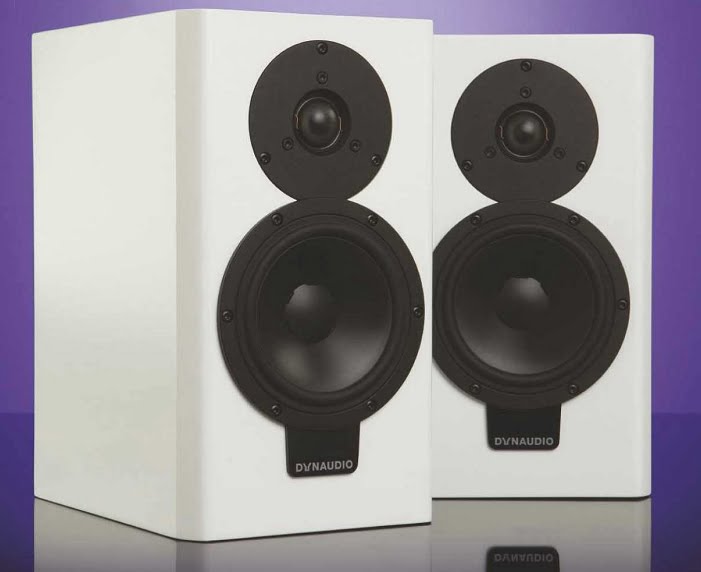
Thirdly, and possibly neatest of all, is the emerging new generation of powered wireless speakers that incorporate all the connectivity of a modern amplifier – some with an on-board DAC and DSP for good measure – delivering a smaller overall footprint and less posterior tangle. Add the sources you require and you’re good to go. KEFs all-embracing LS50 Wireless (HFC 433) and Acoustic Energy’s much simpler AE1 Active (HFC 421) more or less bookend the movement in its current state, though KEFs second contribution to the genre, the LSX (essentially a smaller and more affordable LS50 Wireless – see p6), underlines the company’s belief in its future.
Nearness and flexibility are obvious attractions. But what makes this emerging category so appealing to some in its more technically compelling guise (that’s true active with an amplifier per driver and electronic crossover network rather than passive with an integrated stereo amp housed in one of the enclosures) is the possibility of better sound quality than any similarly priced system using passive speakers, be it a do-it-all hub or coalition of separates. It means that after years of being largely overlooked by a reticent hi-fi community for the more orthodox source and amp with passive speakers approach, the undeniable upsides of active transducer tech, firmly established in the pro sector, are finally finding favour in the home. The traditional case against active (that because the amp is inclusive you can’t buy a bigger, shinier one) carries less clout for those craving a fit-and-forget ‘system solution’ and not a trip down the long and winding upgrade road.
- 7Review earns Amazon affiliate commissions from qualifying purchases.
Time to get active
Danish speaker maker Dynaudio sums it up succinctly with the description for its new Xeo 20. It calls it a compact digital active wireless hi-fi speaker delivering hi-fi performance without the hi-fi system. Much the same could have been said for its predecessor, 2014’s Xeo 4, but along with the softer aesthetic, the refreshed Xeo lineup (which also includes the smaller Xeo 10 standmount and floorstanding Xeo 30) has souped-up sound quality, too.
Facelift? As well as its softened and rounded-off comers, the Xeo 20’s cabinet, sporting a rear-firing slot-type bass port, is slightly larger than the Xeo 4’s and presents a ‘neater and cleaner’ face to the world with the metal elements of the drivers now finished in black and the infra-red receiver moved from the top to just beneath the mid/bass driver, incorporated in a logo plate, for a more balanced-looking baffle when
DETAILS
PRODUCT Dynaudio Xeo 20
ORIGIN Denmark 2-way active wireless standmount loudspeaker
WEIGHT 6.2kg
DIMENSIONS (WxHxD) 180 x 320 x 257mm
FEATURES
•1x 28mm soft dome tweeter •1x 140mm mid/bass driver
- Quoted power output: 4x65W
- Inputs: 1x digital optical; 1x stereo RCAs;1x 3.5mm mini-jack; aptX Bluetooth; wi-fi via add-on Connect unit
DISTRIBUTOR Dynaudio UK
TELEPHONE 01863721089
WEBSITE dynaudio.com
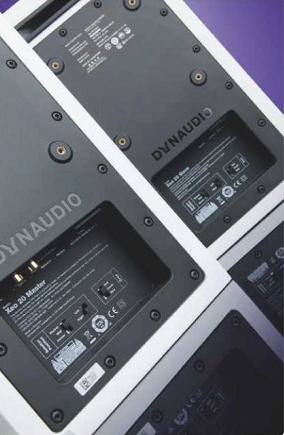
Room placement options are easy to configure
the magnetically attached grille is removed. Dynaudio has a term for it: ‘Nordic simplicity’. Whether you choose the white or black satin lacquer finish, I’d settle for clean, smart and decor-friendly.
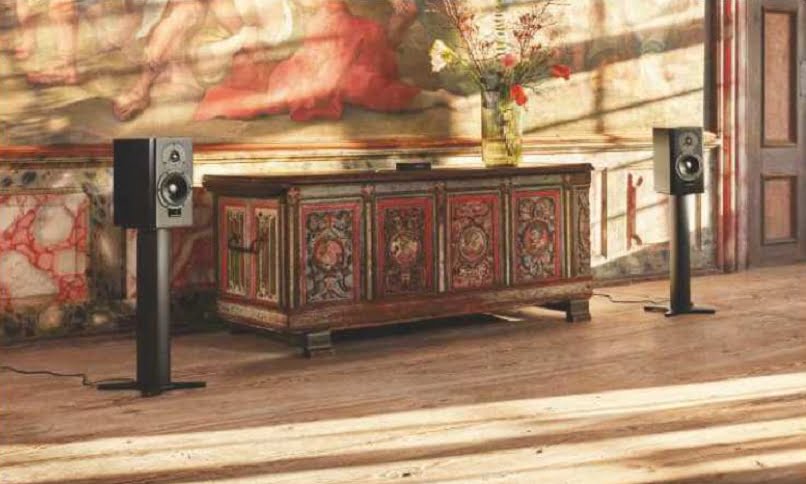
The 140mm Esotec magnesium silicate polymer (MSP) mid/bass driver and 28mm Esotec soft-dome tweeter are no different to those used in the Xeo 4 and each is powered by a dedicated 65W pulse width modulated Class D amplifier module, 15W up on the Xeo 4’s output. But it’s the new, more powerful DSP-derived crossover network (see Q&A), together with the larger internal volume and, not least, zero fluff voicing lifted from Dynaudio’s LYD 5 pro studio nearfield monitor, that are claimed to cement this small speaker’s sonic cred – wherever you want to site it. As well as crossover duties and engineering deeper bass than you might expect from such a modestly sized cabinet, the DSP can EQ for boundary effects. There are three settings catering for wall, corner and free space placements. Nor is sitting down to listen a one-person, one-position (exactly midway between the speakers) deal. The job sheet for the Xeo 20 specified a larger overlap between the drivers’ frequency ranges with the aim of improving not just integration and bass response, but also off-axis performance, widening the sweet spot.
Straight out of the carton, the Xeo 20 offers numerous ways to get going and if you’ve got nearby mains sockets and a sturdy pair of stands already in place – Dynaudio recommends its own sand-fillable Stand 20, but there’s also back plate provision for wall mounts – so much the better. As with the Xeo 4 and, indeed, the smaller Xeo 2 (HFC 411), you must first identify the master speaker – easy enough as it’s the one with the most
If ever there was a perfect example of win-win, the Xeo 20 is surely it connections set into the rear panel. Here you’ll find three direct source inputs: 24-bit/192kHz Toslink digital optical, stereo RCA phono and 3.5mm mini-jack plus a USB port to update firmware. And a dead convenient switch to ‘hand’ the master speaker as left or right channel (there’s a corresponding one on the back of the other speaker). By-passing cables altogether is aptX Bluetooth, which like the physical inputs can be accessed from the supplied remote. The one thing you won’t need is speaker cables as the master speaker communicates with its ‘slave’ via a full-fat 24-bit/96kHz wireless signal. If that isn’t enough, the optional Dynaudio Connect box adds functionality, including multi-room, DLNA and wireless 24-bit/96kHz hi-res audio, though that hasn’t been supplied here.
Sound quality
When I reviewed the previous generation Xeo 2 in my smaller listening room back in HFC 411,1 set the DSP EQ switches to open space and, despite there being only a little more than a foot to the back and side walls, the balance sounded spot on with firm, remarkably well-extended bass given the bijou stature of the speaker. With the larger Xeo 20 on the same Slate Audio stands in the same position and Michael McDonald’s curiously mesmeric, chilled funk version of God Rest Ye Merry Gentlemen from his Season Of Peace Christmas Collection CD in the tray of my Cambridge Audio CXC CD transport (HFC 401) optically connected to the Xeo 20’s on-board DAC, the open space EQ setting isn’t so successful, simply pumping too much bass into the room when the track’s low and weighty bottom notes kick in. Click back through the wall to the corner setting, though, and the rather thick and amorphous low-end quality dissipates and what’s left is impressive control and extension without the extraneous energy. Balance is restored, while believability snaps into place.
And when I say ‘believability’, I mean the kind only a well-designed and engineered active speaker can deliver. Initially, the Xeo 20 seems a little too pristine, a little too squeaky clean, a little too hyper real. Crisp sounds crisper, soft sounds softer, separation crystallizes out of the haze – only it’s a haze you never registered before.
Hearing finer degrees of subtlety and nuance, hearing things for the
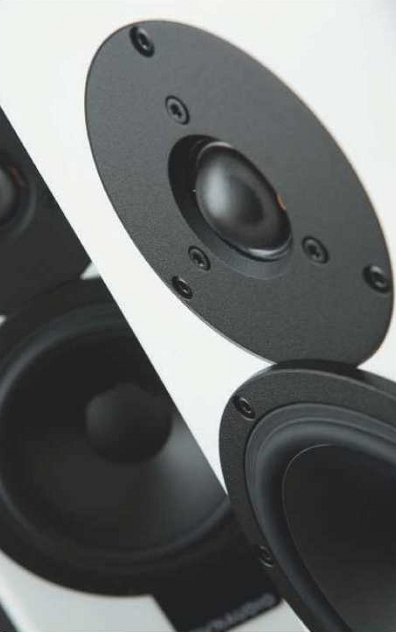
The tweeter and mid/bass driver are the same as those found on the Xeo 4
first time – both are well-worn hi-fi cliches. But I’ve seldom auditioned a two-way standmount where such descriptions have seemed more spookily apt. The swirling textures and wispy organ counterpoints of the background synth wash on God Rest… have a transparency and tender beauty that’s achingly delicate and yet every strand remains clear and distinct when McDonald – seemingly a fully three-dimensional and palpable presence in front of the speakers – challenges the Xeo’s dynamic reach with a soaring, soulful, slightly muffled vocal. Where even good passive speakers tend to blur the quietest detail when things get loud and busy, the active Xeo 20 preserves it and keeps it in perfect proportion, however heartily McDonald fills his lungs. Scalp-prickling stuff.
It’s as if you really are getting an accurate earful of what the recording engineer heard at the mixing desk and with all the imaging solidity and temporal veracity that implies. In this respect, the Xeo 20 sounds quite different to KEFs identically priced LS50 Wireless, which despite its prodigious power and poise is a tad laid back and lush in comparison, though ultimately can go louder and
CONNECT MORE
Dynaudio’s Connect box can be used to expand the Xeo 20’s repertoire, extending its reach to multi-room and hi-res audio with a wi-fi network as well as offering more inputs for additional sources such as a CD player, streamer and turntable. Even the TV needn’t feel left out. And because it uses wi-fi, digital files can be accessed from any DLNA device on the network. This extra functionality joins its built-in aptX Bluetooth support for streaming from any suitably equipped device – including smartphones, tablets and computers, while the digital optical and coaxial inputs accept 24-bit/192kHz hi-res audio files (USB is 24/96). And if you want to stream wireless hi-res to the Xeo 20, Connect also outputs 24-bit/96kHz over the air.
The Connect box automatically hooks up to a home wi-fi network and can stream music directly from any suitable mobile device or computer. It’s equipped with both analogue and digital inputs including a 3.5mm stereo jack, RCA, USB for computers, aptX Bluetooth for mobile devices and the aforementioned 24-bit/192kHz optical and coaxial digital audio inputs.
The free Dynaudio Control app for iOS can be downloaded to replace the Xeo’s handheld remote and controls both speakers directly as well as the Connect box itself. And, conveniently, the app makes it possible to flip between user-nameable inputs, adjust the volume and switch zones in a multi-room setup.
Insights
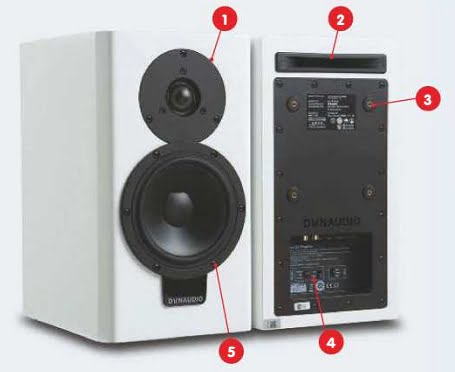
1 28mm soft-dome tweeter
2 Rear-firing bass port slot
3 Wall-mountable fixings
4 DSP switches
5 140mm MSP mid/bass driver
drive a big room more easily. This isn’t to say that the Xeo 20’s can’t switch it up when asked. The latest outing from Muse, Simulation Theory, sounds suitably massive and dense on vinyl as dispatched to the line-level input from my resident Elipson Omega 100 Carbon Black and Rega Fono phono stage. The opener, Algorithm, is a pounding, synth-laced, pomp rock powerhouse that bumps along the ragged edge of overkill so joyously it’s almost a crime not to crank up the volume. The Dynaudio doesn’t mind a bit, giving the track all the low-frequency weight and drive it deserves and, perhaps more remarkably still, great dynamic freedom. It’s enough to break out the air keyboard, but for those less inclined to get carried away just soaking up the pitch-perfect rendition of the instrumental collision and sheer work rate on display could be reward enough.
Conclusion
If ever there was a perfect example of win-win for the hi-fi shopper, the Xeo 20 is surely it. Assuming that high-performance system seekers aren’t set on separates, they’ll be in clover. Yes, it is amazing how good iPlayer Radio 4 can sound via aptX Bluetooth as handled by the active Dynaudio. Moreover, it’s small and smart and doesn’t need an equipment rack. But the real beauty of the Xeo 20 is what it can do with a hi-res digital feed or even CD, not to mention vinyl. Active speakers have been absent from our homes for too long, but thanks to the arrival of designs from KEF, Acoustic Energy and Dynaudio the movement is gathering momentum and, for music lovers, that’s great news
OUR VERDICT
When you purchase through links on our site, I may earn an affiliate commission. Here’s how it works.
Spending £ on ATC’s SCM11 standmount and Rega Brio amp (HFC 422) makes a potent passive/analogue alternative, but lacks the Dynaudio’s two- box simplicity and flexibility. The most obvious rival is KEF’s identically priced LS50 Wireless (HFC 433), which is bigger and weightier, and that’s how it sounds, too. It’s also a little more sophisticated with wi-fi network compatibility and more finely graded DSP EQ options, which means it offers better material value. As for ultimate sound quality, the Xeo 2 just about shades it for musical insight and transparency.
Q&A
Roland Hoffman – Director, Dynaudio Academy
DV: In which areas does the Xeo 20 improve on the Xeo 4 it replaces?
Despite the increased performance, the mid/bass driver and tweeter are in fact the same. The cabinet is slightly taller and wider, allowing a much better bass performance from the larger cabinet volume, but the main benefit comes from the significantly better DSP. It is a much more powerful processor and we’ve used the gained headroom in many ways: full 24-bit/96kHz capability, an improved crossover resolution with a better balance between the two drivers, a more precise speaker placement compensation when positioning the speaker near a wall or corner and an improved limiter algorithm, which makes the speaker sound better and more composed even when playing loud. Last but not least, the amplifiers for the mid/bass and tweeter are more powerful with 2x 65W per speaker, compared with the 2x 50W in the Xeo 4. That’s ultimately a 130W-per-channel stereo amplifier. We’ve also added functionality with analogue and digital direct inputs as well as a Bluetooth receiver on board.
Do you see the sales of active speakers over taking passive types in the future?
When we introduced our first wireless active Xeo generation back in 2012, it was quite a surprise to many.
Since then, Dynaudio’s growth as a company has come from active speaker ranges such as Music, Xeo and Focus XD. So long term, it’s easy to see sales of active speakers overtaking. However, there will always be music enthusiasts more interested in comparing and selecting individual audio components. Dynaudio plans to continue with its passive loudspeakers and will also introduce new models and new technology in its designs, with at least two new ranges to come in 2019.








